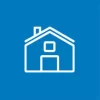Until it was replaced by the SARON, the LIBOR was the most important reference interest rate for Swiss money market mortgages. In Switzerland, the SARON has replaced the LIBOR as the primary money market guide rate.
The interest rate of a LIBOR mortgage (also called a money market mortgage or rollover mortgage) is based on the interbank rate.
Some banks offered a number of LIBOR interest rate variants for mortgages. Mortgages interest rates based on the 3-month LIBOR average and 6-month LIBOR average were common in Switzerland. A few Swiss lenders offered LIBOR mortgages based on the 1-month and/or 12-month average LIBOR.
Which types of property could LIBOR mortgages be used with?
LIBOR mortgages were primarily offered by Swiss banks. Only a few insurance companies (like Swiss Life) offered money market mortgages.
Banks often offered LIBOR mortgages for secondary homes, holiday homes, investment properties and commercial properties in addition to primary residences.
How much did LIBOR mortgages cost?
The cost of LIBOR mortgages was made up of the LIBOR rate plus a markup added by the lender. Interest rates for secondary mortgages were generally higher (0.5 percentage points, for example) than rates for primary mortgages.
When the LIBOR rate was negative, Swiss lenders used a floor of 0% per annum as the base rate in place of the LIBOR. The lender markup was added to the 0% base rate.
As a result, during periods of negative LIBOR base rates, the costs of LIBOR mortgages were made up entirely of lenders’ markups. Markups typically ranged between 0.5% and 1.5% per year.
What were LIBOR markups?
Some lenders used different markups on the LIBOR for different mortgagors, based on each mortgagor’s creditworthiness. It was often possible to negotiate a lower markup to cut the cost of interest charges. Some lenders also offered discounts for energy-efficient buildings and/or discounts for families.
Differences in the costs of LIBOR mortgages from different lenders were not as significant as differences in fixed-rate mortgages from different lenders. Still, savings potential between the cheapest and most expensive LIBOR mortgages could reach thousands of francs per year.
Which mortgage terms were offered?
LIBOR mortgages were generally offered with mortgage terms of between 1 and 6 years. The most widely-offered LIBOR mortgage term was 3 years. Some lenders offered 10-year LIBOR mortgage terms. Banks like UBS and PostFinance only offered 3-year LIBOR mortgage terms.
What was the minimum size for a LIBOR mortgage?
Normally, lenders only offered LIBOR mortgages above a minimum mortgage size. The minimum size varied between lenders, but typically ranged between 100,000 and 200,000 Swiss francs.
Only a few lenders (primarily online mortgages) placed limits on the maximum mortgage size. With regards to collateralization and affordability, the requirements were identical to those for fixed-rate mortgages.
When did using LIBOR mortgages make sense?
Getting a LIBOR mortgage generally only made financial sense during periods when money market interest rates were very low. When such periods extended over several years or more, mortgagors could benefit from ongoing low interest rates. On the other hand, during times when money market rates climbed over longer periods, fixed-rate mortgages were often the more affordable option.
In every case, whether or not using a LIBOR mortgage was financially advantageous depended on how money markets developed over the mortgage term. The problem: There was no way to know how money markets would develop in the future at the time of getting the mortgage. A number of Swiss institutes regularly published money market interest rate predictions which served as a point of reference for prospective mortgagors.
How could a mortgagor hedge against rising interest rates?
The longer the term of a LIBOR mortgage was, the higher the risk of interest rates becoming unfavorable was. Swiss banks offered optional risk protection which mortgagors could add to their mortgages to protect against rate changes. This optional protection capped the maximum interest rate which could apply to a LIBOR mortgage. Mortgagors would never pay more than the maximum rate, even if the LIBOR climbed above that. However, lenders charged fees for this risk protection, so adding it made a LIBOR mortgage more expensive.
Many LIBOR mortgage agreements came with the option of converting the mortgage to a fixed-rate mortgage from the same lender. It was up to mortgagors to determine whether their mortgage agreements included such a conversion clause.
What were the advantages of LIBOR mortgages?
- During periods when money market interest rates were low, mortgagors quickly benefited from reductions in their interest rates thanks to the regular adjustment intervals. With most LIBOR mortgages, the interest rates were adjusted semi-annually or quarterly. So, LIBOR mortgages provided greater flexibility than fixed-rate mortgages.
- Even when interest rates remained constant, LIBOR mortgages still provided an affordable alternative to fixed-rate mortgages.
- Over the last 20 years, LIBOR mortgages were cheaper, on average, than fixed-rate mortgages.
What were the disadvantages of LIBOR mortgages?
- Risk of unfavorable interest rate adjustments: If interest rates climbed sharply, LIBOR mortgages could become expensive. Over extended periods of climbing money market interest rates, fixed-rate mortgages were the cheaper option. in order to minimize this risk, many mortgagors combined LIBOR and fixed-rate mortgages.
- Unlike adjustable-rate mortgages, terminating a LIBOR mortgage before the end of the pre-agreed mortgage term incurred penalty fees (as with fixed-rate mortgages).
- The relatively short terms and variable interest rates make it impossible to calculate the exact cost of a LIBOR mortgage in advance. Fixed-rate mortgages, on the other hand, do allow for exact budgeting.
More on this topic:
SARON mortgages: Questions and answers
Compare Swiss mortgages now
LIBOR mortgages explained
LIBOR explained


 Deal of the Day
Deal of the Day 









